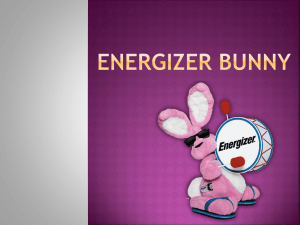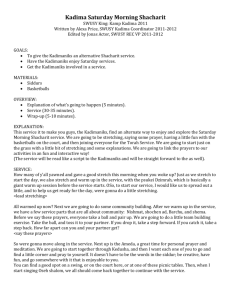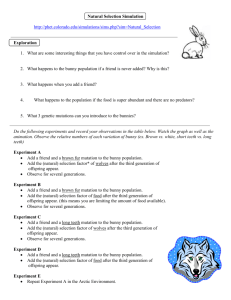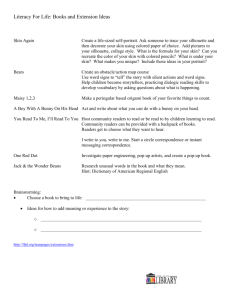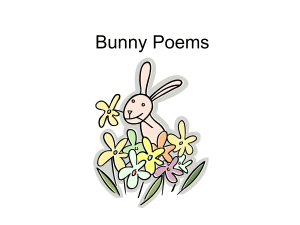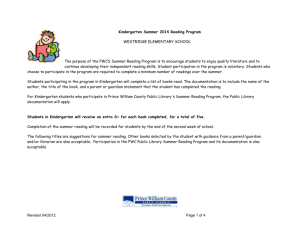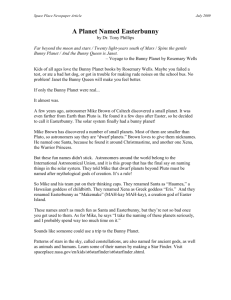Analysis of a Picture Book
advertisement
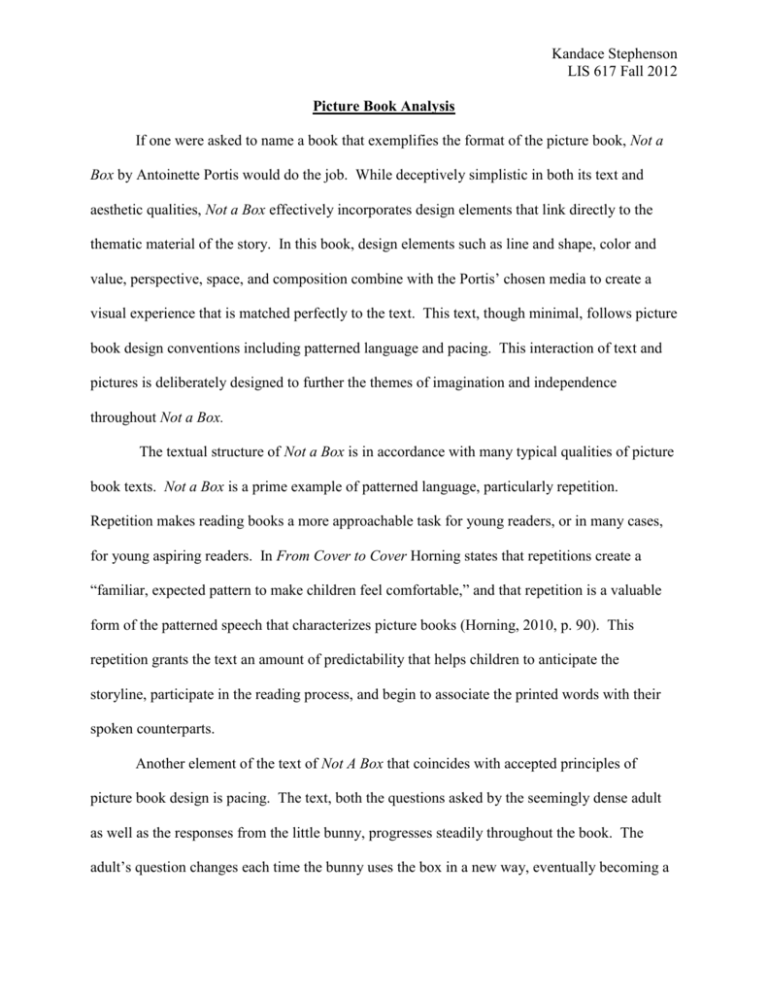
Kandace Stephenson LIS 617 Fall 2012 Picture Book Analysis If one were asked to name a book that exemplifies the format of the picture book, Not a Box by Antoinette Portis would do the job. While deceptively simplistic in both its text and aesthetic qualities, Not a Box effectively incorporates design elements that link directly to the thematic material of the story. In this book, design elements such as line and shape, color and value, perspective, space, and composition combine with the Portis’ chosen media to create a visual experience that is matched perfectly to the text. This text, though minimal, follows picture book design conventions including patterned language and pacing. This interaction of text and pictures is deliberately designed to further the themes of imagination and independence throughout Not a Box. The textual structure of Not a Box is in accordance with many typical qualities of picture book texts. Not a Box is a prime example of patterned language, particularly repetition. Repetition makes reading books a more approachable task for young readers, or in many cases, for young aspiring readers. In From Cover to Cover Horning states that repetitions create a “familiar, expected pattern to make children feel comfortable,” and that repetition is a valuable form of the patterned speech that characterizes picture books (Horning, 2010, p. 90). This repetition grants the text an amount of predictability that helps children to anticipate the storyline, participate in the reading process, and begin to associate the printed words with their spoken counterparts. Another element of the text of Not A Box that coincides with accepted principles of picture book design is pacing. The text, both the questions asked by the seemingly dense adult as well as the responses from the little bunny, progresses steadily throughout the book. The adult’s question changes each time the bunny uses the box in a new way, eventually becoming a Stephenson 2 bit more irritable or impatient as on the pages that read “Now you’re wearing a box?” and “Are you still standing around in that box?” The bunny’s responses slowly add more to the repeated statement that the box is, in fact, “not a box,” ending with the bunny’s exclamation “It’s NOT NOT NOT NOT a box!” This pacing is consistent with the traditional framework of a story (exposition, rising action, climax, falling action, resolution) that we have discussed in class to be characteristic of easy-reader picture books as well as books of more difficult reading levels. The pacing of the text is also perfectly matched to the illustrations, a prime example being the page opposite “It’s NOT NOT NOT NOT a box!” that includes (for the first and only time in the book) not one, but four images of the bunny on his imaginary adventures. The illustrations in this book are truly characteristic of a picture book as they not only enrich the story, but drive it and define its meaning. The illustrations are minimalistic, with flat line drawings being the only form of media. While the little bunny’s imaginative activities and destinations could have been conveyed using fanciful three-dimensional drawings or more complex forms of media, I think the line drawings are appropriately paired with the theme of the story. The bunny is physically working with minimal materials but is able to create anything he likes in his head, and I think the clean and thick line drawing form of illustration is a design element consciously chosen to foster this idea. Not a Box, thanks to its line drawing style of illustration, demonstrates nearly textbook uses of the design elements of line and shape. The little bunny is made up of curves and rounded shapes, which we have discussed in class as conveying a feeling of comfort and familiarity. This natural feeling of comfort allows readers to identify with the bunny and creates a connection between the reader and the main character of the book. In Picture This: How Pictures Work Molly Bang describes horizontal lines as providing a sense of stability, which is what the Stephenson 3 grounded image of the box gives to each picture in the story. The vertical elements of the little bunny, particularly his perky ears, lend to the story a quality of excitement, activity, and energy, to which Bang also attests. This is particularly evident on the page of Not a Box on which the little rabbit has climbed to the top of Rabbit Peak and even his arms are reaching for the sky, visually indicating the excitement he feels from his imaginary accomplishment. Finally, Portis makes significant use of the design element of diagonals. In the pages preceding the beginning of the story the little rabbit can be seen struggling to push and pull his box to the first page where he will begin his adventures, and the diagonal line of his body indicates the energy he is feeding into this task. Additionally, diagonal shapes are integral aspects of the final pages on which the bunny blasts off into space in his Not-a-Box. Bang states that “diagonal shapes are dynamic because they imply motion or tension” (Bang, 2000, p. 46). It is on account of this use of diagonal shapes that the power of the little bunny’s imagination is conveyed to the reader. While the design elements of color and value are not the same, I believe they are linked in valuable ways in Not a Box. The color palette used in this book is limited. The pages on which the adult speaks are the color of the little bunny’s cardboard box, and the background behind the bunny opposite those pages, undoubtedly what this adult questioner is seeing, is plain white. However, the bunny’s “not a box” responses always greet the reader on a red background, and the drawings of his imagination place the black line drawn bunny and box in a red line drawn adventure on a bright yellow background. This color scheme persists throughout the entire text. Each of the bunny’s adventures could have occurred using a different pair of colors, however Portis’ design choice demonstrates the value of Molly Bang’s principle that “we associate the same or similar colors much more strongly than we associate the same or similar shapes” (Bang, 2000, p. 76). The chosen colors also invoke a subconscious evaluation of the Stephenson 4 bunny’s character, as red indicates energy, determination and passion and yellow indicates joy, intellect, and happiness. On the pages upon which the bunny’s imagination is illustrated, the bright red lines exert dominance over the black lines of the bunny and the box, bringing the imagined image to the forefront. The value of these color choices remains the same throughout the book as well. In class we discussed that successful images have a range of tonal contrast, however I believe that this lack of contrast in value coincides with the significance of the lack of color variation. The consistency in color and value implies that each of the bunny’s imagined destinations is possible using just the mind and materials present. The perspective used in Not a Box is another element that remains consistent and fairly predictable throughout. The little bunny is fairly large on the page, but small enough that until the drawings of his imagination fill the page he looks a bit lost and isolated with his simple box. The point of view of Not a Box is closely associated with Portis’ use of space. The little bunny is typically placed in the center of the page, therefore being the center of attention. However, when the page is turned, the bunny’s imagination runs off of the page in almost every instance, showing that the little bunny’s adventures are grander than his “picture-world” will allow (Bang, 2000, p. 66). This reminds me of Horning’s description of Millions of Cats, in which she discusses Wanda Gag’s use of negative space to show the passing of time (Horning, 2010, p. 85). In Not a Box, Portis uses the vast amount of white space to emphasize the extent of the possibilities the little bunny’s imagination has to fill this physical space and beyond. The composition of Not a Box contributes significantly to the effectiveness of the patterned language and pacing of the text. Throughout the book the text appears on the left page and the image of the little bunny (either with his box or in his imagination) appears on the right page. This continues until the end of the story, when the bunny allows his not-a-box to fully take Stephenson 5 over and dispel the somewhat scolding tone of the questioning adult both in multiple panels of images from his imagination or, finally, in a double-page spread and a final page of his imagination taking off through space. There is a bit of variety in the composition, as the bunny always begins in a new position in or on his box when he is once again asked what he is up to. However, unity is achieved throughout by the consistency of the bunny’s placement near the center of the page. Unity for the entire story as a whole is also achieved through the story’s “packaging.” The story really begins as soon as you open the book, seeing the bunny dragging his box toward the true “first page.” The front and back covers of the book even look and feel like the little bunny’s cardboard box, complete with net weight and “this side up” markings. Portis’ choice to depict the book as a box illustrates the book as a bit of a constraint just as the box is depicted in the story, but with the help of the little bunny the reader can find that there is imagination and excitement hidden within. Although it is probably obvious from my analysis of the design of Not a Box, I must say I really enjoyed reading this book. I think that the subject matter is something to which all children could relate, and even as an adult I am reminded of my childhood when I read this book. I feel that the aesthetic elements of this book suit the text and the subject perfectly, and I appreciate the basic quality of the drawings and stylistic elements. I like that this book invites young readers to imagine and play. The little bunny in this book is shown to be quite independent and he demonstrates that playing alone can be comfortable and fun, which is a concept that I think many children struggle with. Most importantly I believe that Not a Box conveys the idea that even if someone does not have much to work with there is still potential for fun and excitement. I think that, for children, our culture is one of batteries and televisions, and that the art of playing through imagination is slowly being Stephenson 6 lost. I used to teach children’s ballet classes, and over time I found that the children’s favorite activity at the end of class was to “dance” the way certain animals would dance. I would ask them to dance like they were cats, birds, turtles, rabbits, and so on, and the children had a great time letting their imaginations show through motion. However, I was always saddened by the fact that there would be a child or two that seemed embarrassed, even at age 5, to be publicly displaying the contents of their imagination. I think that Not a Box counteracts this notion and inspires children to shamelessly use their imaginations to their advantage, encouraging them to enjoy even the smallest or most basic activities. Stephenson 7 Bibliography Bang, M. (2000). Picture this: How pictures work. San Francisco: Chronicle Books. Gann, L. (2012). The art of picture books: Choice of media [Powerpoint slides]. Retrieved from UNCG Blackboard website: https://blackboard.uncg.edu/bbcswebdav/pid-2278018dt-content-rid-5438813_2/xid-5438813_2 ---. (2012). The art of picture books: Elements of design [Powerpoint slides]. Retrieved from UNCG Blackboard website: https://blackboard.uncg.edu/bbcswebdav/pid-2278017dt-content-rid-5450965_2/xid-5450965_2 Horning, K.T. (2010). From cover to cover: Evaluating and reviewing children’s books (revised ed.). New York: HarperCollins. Portis, A. (2006). Not a Box. New York: HarperCollins.

